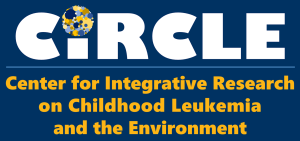CIRCLE investigators translate research for pediatricians, emphasize importance of efforts to prevent childhood leukemia.
There is a perception among the medical community at large and among pediatricians in particular, that the causes of childhood cancer are completely mysterious. However, in contrast to most other pediatric cancers, there is growing evidence that several environmental hazards increase the risk of childhood leukemia. Despite the strength of the existing proof, the dissemination of this knowledge to clinicians has been limited.
In an effort to bring pediatricians up-to-speed on the currently-accepted risk factors for childhood leukemia and to encourage a discourse that would lead to childhood leukemia prevention programs, CIRCLE investigators Catherine Metayer, Gary Dahl, Joe Wiemels, Todd Whitehead, Amanda Singer, and Mark Miller recently published two journal articles: “Childhood Leukemia: A Preventable Disease” (published in the November issue of Pediatrics) and “Childhood Leukemia and Primary Prevention” (published in the October issue of Current Problems in Pediatric and Adolescent Health Care).
CIRCLE investigators have been at the forefront of identifying environmental causes of childhood leukemia, including through their leadership roles in the Childhood Leukemia International Consortium. The Consortium has demonstrated the risk of developing childhood leukemia is consistently positively associated with exposures to solvents, traffic, pesticides, and tobacco smoke in studies from all over the world. Likewise, the intake of vitamins and folate supplementation during the preconception period or pregnancy has been demonstrated to have a protective effect.
CIRCLE investigators have also shown that some children may be more vulnerable to leukemia than others, as documented by the high and increasing incidence of childhood leukemia in California Latinos.
In their reviews, the authors argue that it would be prudent to establish cancer-prevention programs that are designed to limit exposure to existing leukemia risk factors. They suggest prevention programs are particularly warranted because the same environmental exposures that have been implicated as risk factors for childhood leukemia also cause other serious health outcomes.


